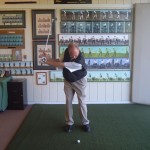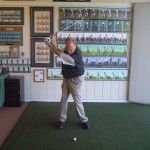02 Apr Pitching: Distance control, the key too scoring.
Golfers spend the whole of their lives working on how to score better. They take lessons, see The Golf Channel, read books, watch videos and listen to everyone under the sun. Usually these searches in an effort to figure out how to strike the ball better.
However, the key to scoring is how quickly we get the ball into the hole.
There are many elements that affect our goal, of getting the ball into the hole, but from any yardage Distance Control is most important. The closer we hit our ball to the cup, the better our chances are to lower our score..
- Short Pitch
- Medium Pitch
- Long Pitch
[dropshadowbox align=”none” effect=”lifted-both” width=”870px” height=”” background_color=”#ffffff” border_width=”1″ border_color=”#dddddd” ]There are four ways a golfer can adjust the distances they are trying to make their ball to travel. Club selection, set up, length of swing and speed of swing, we will use these four cornerstones to help make your ball go the specific yardage you are shooting for. All of the yardages that I speak of are individual to each golfer and are to be figured out only through practice. The adjustments we will make are nearly all made before the actual swing ever takes place.[/dropshadowbox]
The Short Pitch: A short pitch is a lofted shot that carries a specific distance and is often over rough or hazards. The pitch shot is designed to stop quickly near the target we have chosen. Club selection is vital in achieving the best result. As many golfers carry three wedges today, the short pitch requires the most lofted wedge in the bag. This wedge will generally have 58 or 60 degrees of loft.
After this choice is made it is best to choke down on the handle until the right forefinger is near the bottom of the grip. Shortening the club makes the club/lever less and gives the player more control of the club. The shortening of the hand position also generates less club head speed and makes the ball travel a shorter distance.
The next set up adjustment is to narrow the feet to a point of having only two inches between the inside of each foot and having a majority of the weight on the left side. The legs and hip rotation are primary sources of power in the golf swing and this narrowing of the feet will produce less pivoting and ultimately less power. The narrowing will also decrease lower body movement, minimizing the chance for a misplayed shot.
Now that all of the necessary adjustments have been made to the setup and club selection, the swing can be made. Try to liken your distance of the swing to that of an underhanded toss. Professionals can often be observed emulating this tossing motion in their pre-shot routines. In using a clock dial for reference, the swinging motion should travel from 8 o’clock to 4 o’clock for the short pitch.
The Medium Pitch: This shot obviously becomes longer than the shot previously described. Using the same, highest loft club, as the Short Pitch, our hands are placed on the club in the middle of the grip. (Equal amount of grip below the bottom hand and above the top hand) The foot position will widen to a medium width. (This to produce lower body turning that will create additional power) The swinging motion of the arms will then become higher on the clock dial. This will move the arms from 9 o’clock to 3 o’clock. The accumulation of these changes in the hands, foot position, body turn and arm swing will allow the ball to smoothly travel a longer distance.
The Long Pitch: This shot is closely connected to the full swing. We will be trying to get 85% of the distance out of the most lofted wedge we have. It will be rare to ever play a wedge at full power for this will make the ball travel too high, with too much backspin and inconsistent distances. Now, we place our hands on the club at the top of the handle to give the club/lever its full power. Our feet widen to the full width of our hips to create the ability to fully pivot. This full pivoting motion will then allow our arms to swing on the clock dial from 10 o’clock to 2 o’clock. The accumulation of these adjustments let the club, arms and body to maximize the distance of our turning and swing.
I have given each of you the ability to now play three different distances with one golf club. All you have done is adjust the hand position, foot position, and amount of swing with the arms and body. The system I have explained to you continues with the Gap wedge or next wedge in your bag, (giving you three distances with it as well) and ends with the Pitching wedge. (Three more distances there) Now every golfer has nine available distance choices with only three golf clubs. All of your distances should now be comfortably played with whatever wedge or loft arrangement you presently have in your bag.
Learn the distances of your shots one club at a time when using these three different set up’s. Do this to no specific target so that you may correctly find out how much yardage you will get out of each set up change. The knowledge you will build using this system gives confidence in club selection and enhances trust in your golf swing mechanics. This wedge system will take strokes off your game quickly, one pitch at a time.






